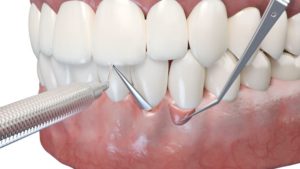
If gum disease or other problems have caused significant gum recession, you may face a number of difficulties. For example, you might feel self-conscious about the way your teeth look. Plus, your exposed tooth roots are more vulnerable to outside stimuli, which can cause discomfort. You should not expect your lost gum tissue to regrow on its own. However, a skilled periodontist (dentist who specializes in gum health) may be able to perform a gum graft to help you get your oral health back on track. There are a few different types of gum grafts, including:
Connective Tissue Grafts
This is the most commonly used method to cover exposed tooth roots. During the procedure, a periodontist makes an incision in the roof of your mouth (called the palate). Tissue from underneath the flap, called subepithelial connective tissue, is gently removed. That tissue is then stitched onto the gums at the site of an exposed tooth root. Once the connective tissue is removed from the palate, the flap is stitched down so the mouth can heal properly.
Free Gingival Grafts
Just like a connective tissue graft, a free gingival graft involves the use of tissue from the palate. However, instead of creating a flap and taking tissue from underneath it, a bit of tissue is removed directly from the roof of the mouth and then stitched onto the gums. This technique is often used for people who have thin gums and need extra tissue to protect their teeth.
Pedicle Grafts
During a pedicle graft, a periodontist takes tissue from the gums near the tooth that needs repair. However, instead of completely cutting away the tissue, they create a flap, letting part of the gums stay attached. They then pull the tissue so it covers exposed tooth roots. This procedure is only possible in individuals who have a good amount of gum tissue around their exposed tooth root.
What to Expect from a Gum Graft
If you need to undergo a gum graft, you can expect your periodontist to make your experience as comfortable as possible during your surgery. Recovery usually takes a couple of weeks, after which swelling should subside, and you will be able to enjoy your smile’s new look. Plus, you may notice reduced dental sensitivity.
Gum grafting might be able to help you get back on the road to a healthy smile! Ask your periodontist if you have questions about how this procedure works.
Meet the Practice
Dr. Bita Farhoumand is a Diplomate of the American Board of Periodontology. She has helped countless patients to recover from gum disease, gum recession, and related issues, and she approaches every case with empathy and care. If you believe you could benefit from her services, contact our Vista, CA, office at 703-981-3185.
 (760) 470-4664
(760) 470-4664



